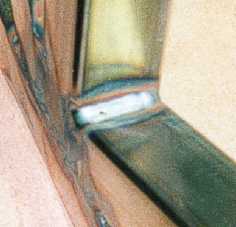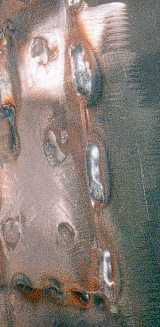Mig Welding (Metal
Inert Gas)
Mig welding is an electric welding process that is probably one of the
easiest forms of welding to learn but it takes time and skill to really master.
It is quick but produces splatter and smoke. For best results the metal has
to be clean but dirty metal can be welded. The main components of Mig welding
are the main control unit and a torch out of which the filler wire runs and
an inert gas flows. An arc strikes between the filler wire and the metal.
A button on the torch starts the wire feed and current.


Mig torch and earth clamp.
Close up of the Mig torch.
In Mig welding the filler wire comes out of the centre of the shroud as in the picture above. There are controls on the main unit to set the speed of the wire and current. As the filler wire makes the arc you have less control (than Tig welding) of how much metal goes into the weld. This gives rise to the common appearance of Mig welds looking like toothpaste squeezed out of a tube. However if the current and wire speed are set correctly, flat looking welds can be achieved. Spatter can be a problem and may require removal after welding, but clean metal and anti spatter spray (does not prevent spatter but prevents it sticking) minimises the problem.
Mig can be used for welding steel and aluminium but the filler wire and shielding
gas must be changed.
I quite often Mig weld by doing lots of spots. This means that I can have
high current for good penetration, but because I am spotting the weld has
time to cool between welds preventing blow through. Also there is more control
of the amount of metal being added. Higher spec. machines have pulse settings
so the spotting is done automatically without having to press the button on
the torch.


The above pictures are examples of MIG welding. The fillet on the left fills the corner nicely but the welds on the picture on the right have a little too much weld on them. I tend to use MIG on thin body work because it is quick. This means less heat goes in and less distortion. It is also ideal for doing plug welds (where two flat pieces are being joined and a hole is drilled in the top piece and you weld through the hole joining the two together. Its like a big spot weld.) because you require filler wire to fill the hole.